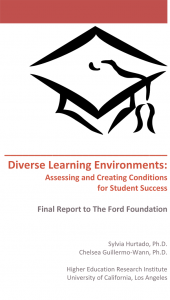 The challenge of higher education is to prepare students for a vision of the local and global society we aspire to become—one that is focused on advancing social progress and is equitable, interdependent, sustainable, innovative, and economically secure for the welfare of all. This new vision of society calls for equipping students with the values, skills, and knowledge to become complex thinkers and ethical decision–makers in a society currently plagued with conflict and inequality. It also calls for assessing where our students begin, how they grow and change, and how our educational practices contribute to undergraduate education goals that will achieve this vision. As postsecondary institutions enter an era of ”evidence-based“ practice, and take greater responsibility for monitoring student outcomes, we must also aim to assess the context of diverse learning environments that impact these outcomes. If we do not assess diverse learning environments, assessment instruments of student outcomes will simply document the cycle of disparities in educational outcomes (traced back to preparation prior to college) without identifying areas for improving student learning and development. This would be a disservice to students who have overcome significant obstacles and arrive at our doorsteps or ”portals“ to learn. Integrating assessments of student outcomes, the climate for diversity, and campus practices may be the best strategy to ensure all students are well-served to be successful and to maximize the benefits of diverse learning environments for citizenship in a diverse society.
The challenge of higher education is to prepare students for a vision of the local and global society we aspire to become—one that is focused on advancing social progress and is equitable, interdependent, sustainable, innovative, and economically secure for the welfare of all. This new vision of society calls for equipping students with the values, skills, and knowledge to become complex thinkers and ethical decision–makers in a society currently plagued with conflict and inequality. It also calls for assessing where our students begin, how they grow and change, and how our educational practices contribute to undergraduate education goals that will achieve this vision. As postsecondary institutions enter an era of ”evidence-based“ practice, and take greater responsibility for monitoring student outcomes, we must also aim to assess the context of diverse learning environments that impact these outcomes. If we do not assess diverse learning environments, assessment instruments of student outcomes will simply document the cycle of disparities in educational outcomes (traced back to preparation prior to college) without identifying areas for improving student learning and development. This would be a disservice to students who have overcome significant obstacles and arrive at our doorsteps or ”portals“ to learn. Integrating assessments of student outcomes, the climate for diversity, and campus practices may be the best strategy to ensure all students are well-served to be successful and to maximize the benefits of diverse learning environments for citizenship in a diverse society.
The Diverse Learning Environments project will embark on a set of research and practice initiatives to address equity, diversity, and educational outcomes at multiple levels of analysis: student level assessment, at the institutional level in terms of assessment of the diverse learning environments, and at the multi-institutional comparisons at pilot institutions (including broad access campuses) as well as national comparison information that will be generated over the life of the project. Embedded in the development of each initiative are explicit ways to “scale up” the work so that many more individuals (researchers and educators) and institutions are engaged in maximizing the conditions for learning in diverse environments. All initiatives are connected with use of research for the improvement of practices that advance student success.
